2011 HYUNDAI TUCSON headrest
[x] Cancel search: headrestPage 20 of 382
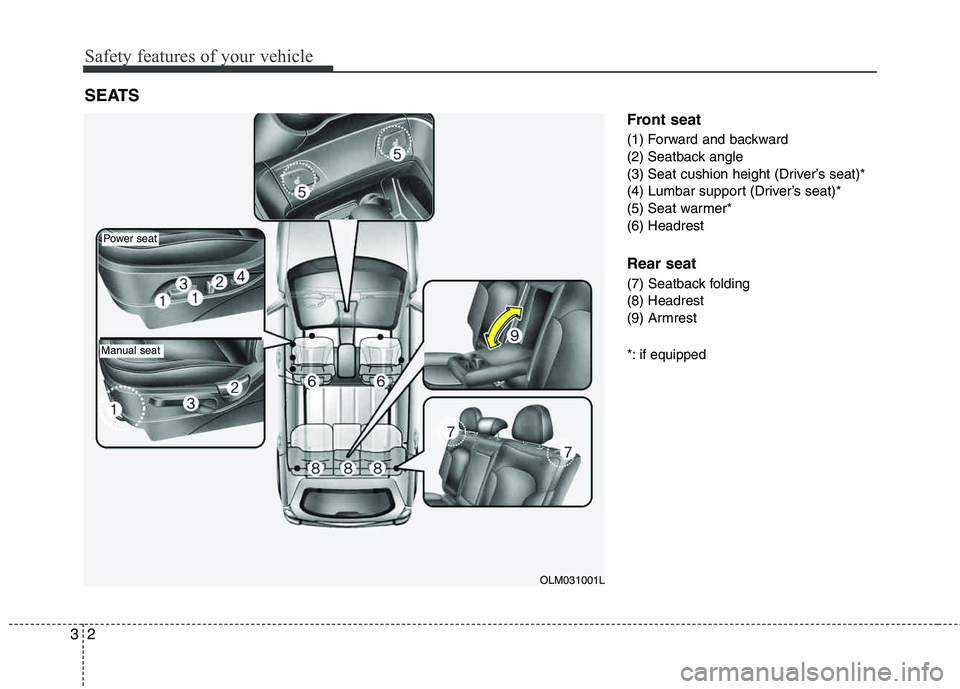
Safety features of your vehicle
2
3
Front seat
(1) Forward and backward
(2) Seatback angle
(3) Seat cushion height (Driver’s seat)*
(4) Lumbar support (Driver’s seat)*
(5) Seat warmer* (6) Headrest
Rear seat
(7) Seatback folding (8) Headrest
(9) Armrest
*: if equipped
SEATS
OLM031001L
Manual seat
Power seat
Page 26 of 382
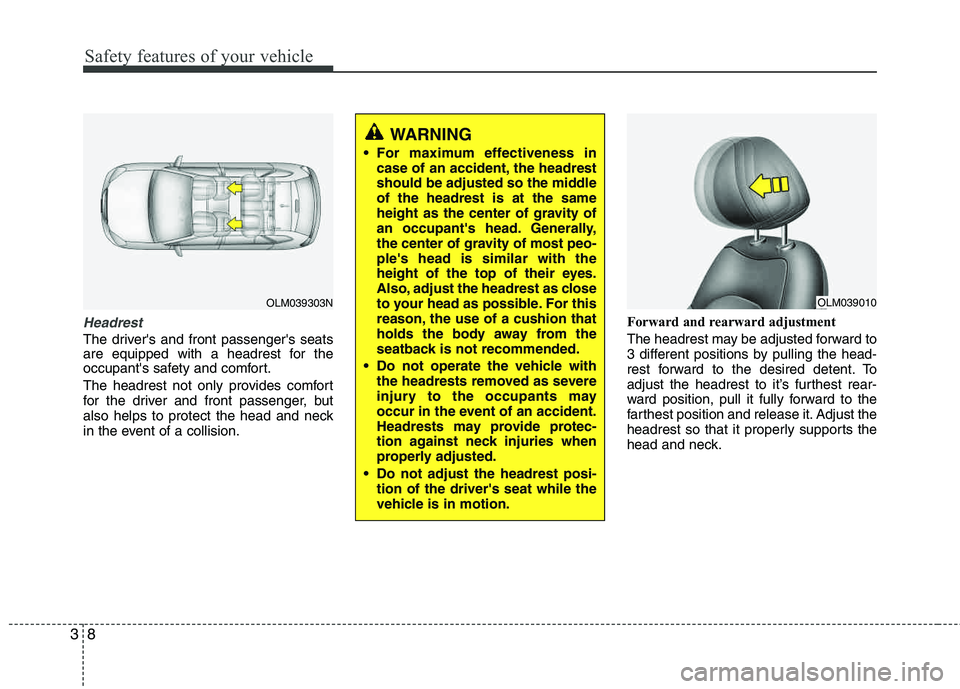
Safety features of your vehicle
8
3
Headrest
The driver's and front passenger's seats
are equipped with a headrest for the
occupant's safety and comfort.
The headrest not only provides comfort
for the driver and front passenger, but
also helps to protect the head and neck
in the event of a collision. Forward and rearward adjustment
The headrest may be adjusted forward to
3 different positions by pulling the head-
rest forward to the desired detent. To
adjust the headrest to it’s furthest rear-
ward position, pull it fully forward to the
farthest position and release it. Adjust the
headrest so that it properly supports the
head and neck.
OLM039303N
WARNING
For maximum effectiveness in case of an accident, the headrest
should be adjusted so the middleof the headrest is at the same
height as the center of gravity of
an occupant's head. Generally,
the center of gravity of most peo- ple's head is similar with the
height of the top of their eyes.
Also, adjust the headrest as close
to your head as possible. For this
reason, the use of a cushion that
holds the body away from the
seatback is not recommended.
Do not operate the vehicle with the headrests removed as severe
injury to the occupants may
occur in the event of an accident.
Headrests may provide protec-
tion against neck injuries when
properly adjusted.
Do not adjust the headrest posi- tion of the driver's seat while the
vehicle is in motion.
OLM039010
Page 27 of 382
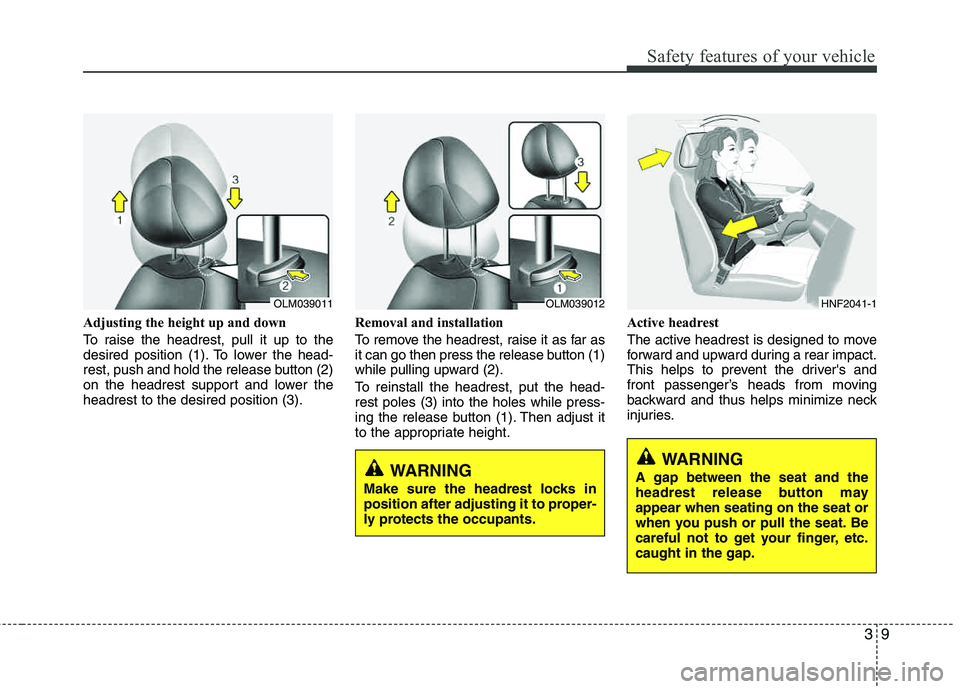
39
Safety features of your vehicle
Adjusting the height up and down
To raise the headrest, pull it up to the
desired position (1). To lower the head-
rest, push and hold the release button (2)
on the headrest support and lower the headrest to the desired position (3).Removal and installation
To remove the headrest, raise it as far as
it can go then press the release button (1)
while pulling upward (2).
To reinstall the headrest, put the head- rest poles (3) into the holes while press-
ing the release button (1). Then adjust it
to the appropriate height.Active headrest
The active headrest is designed to move
forward and upward during a rear impact.
This helps to prevent the driver's and
front passenger’s heads from moving
backward and thus helps minimize neck
injuries.
OLM039011OLM039012HNF2041-1
WARNING
Make sure the headrest locks in
position after adjusting it to proper-
ly protects the occupants.WARNING
A gap between the seat and the
headrest release button mayappear when seating on the seat or
when you push or pull the seat. Be
careful not to get your finger, etc.caught in the gap.
Page 30 of 382
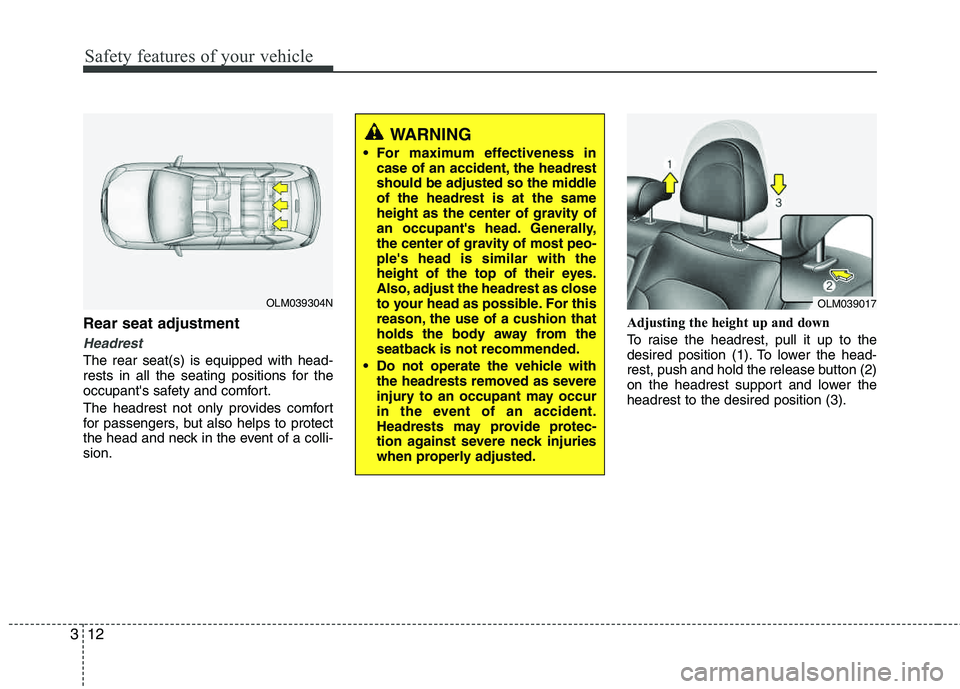
Safety features of your vehicle
12
3
Rear seat adjustment
Headrest
The rear seat(s) is equipped with head-
rests in all the seating positions for the
occupant's safety and comfort.
The headrest not only provides comfort
for passengers, but also helps to protect
the head and neck in the event of a colli- sion. Adjusting the height up and down
To raise the headrest, pull it up to the
desired position (1). To lower the head-
rest, push and hold the release button (2)
on the headrest support and lower theheadrest to the desired position (3).
WARNING
For maximum effectiveness in case of an accident, the headrest
should be adjusted so the middleof the headrest is at the same
height as the center of gravity of
an occupant's head. Generally,
the center of gravity of most peo- ple's head is similar with the
height of the top of their eyes.
Also, adjust the headrest as close
to your head as possible. For this
reason, the use of a cushion that
holds the body away from the
seatback is not recommended.
Do not operate the vehicle with the headrests removed as severe
injury to an occupant may occur
in the event of an accident.
Headrests may provide protec-
tion against severe neck injuries
when properly adjusted.
OLM039304NOLM039017
Page 31 of 382
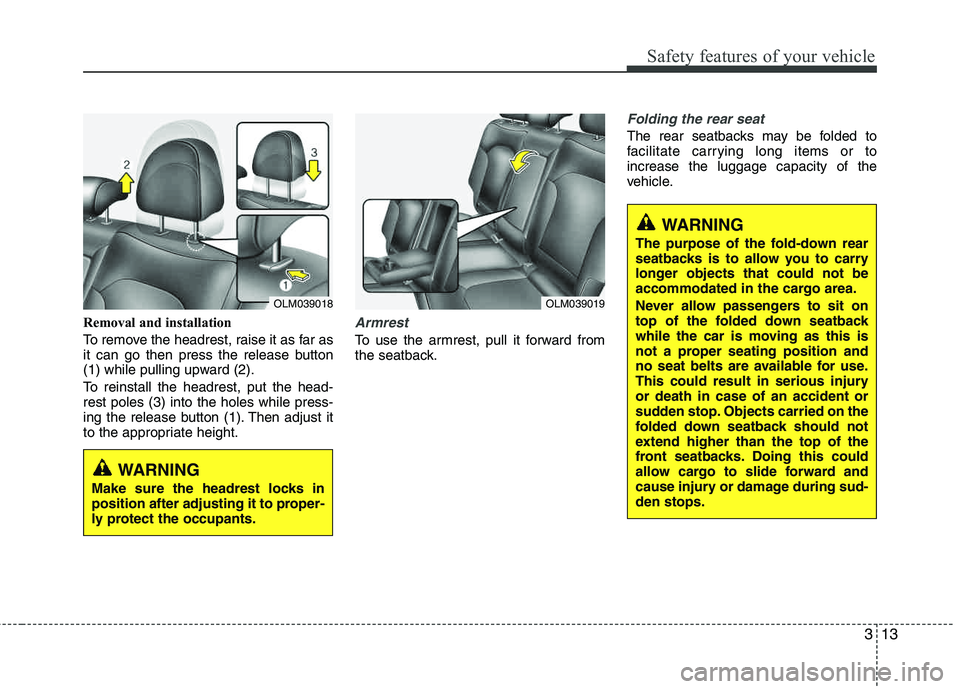
313
Safety features of your vehicle
Removal and installation
To remove the headrest, raise it as far as
it can go then press the release button
(1) while pulling upward (2).
To reinstall the headrest, put the head- rest poles (3) into the holes while press-
ing the release button (1). Then adjust it
to the appropriate height.Armrest
To use the armrest, pull it forward from
the seatback.
Folding the rear seat
The rear seatbacks may be folded to
facilitate carrying long items or toincrease the luggage capacity of the
vehicle.
OLM039018OLM039019
WARNING
Make sure the headrest locks in
position after adjusting it to proper-
ly protect the occupants.
WARNING
The purpose of the fold-down rear
seatbacks is to allow you to carry
longer objects that could not be
accommodated in the cargo area.
Never allow passengers to sit on
top of the folded down seatback
while the car is moving as this is
not a proper seating position and
no seat belts are available for use.
This could result in serious injury or death in case of an accident or
sudden stop. Objects carried on the
folded down seatback should not
extend higher than the top of the
front seatbacks. Doing this could
allow cargo to slide forward and
cause injury or damage during sud- den stops.
Page 32 of 382
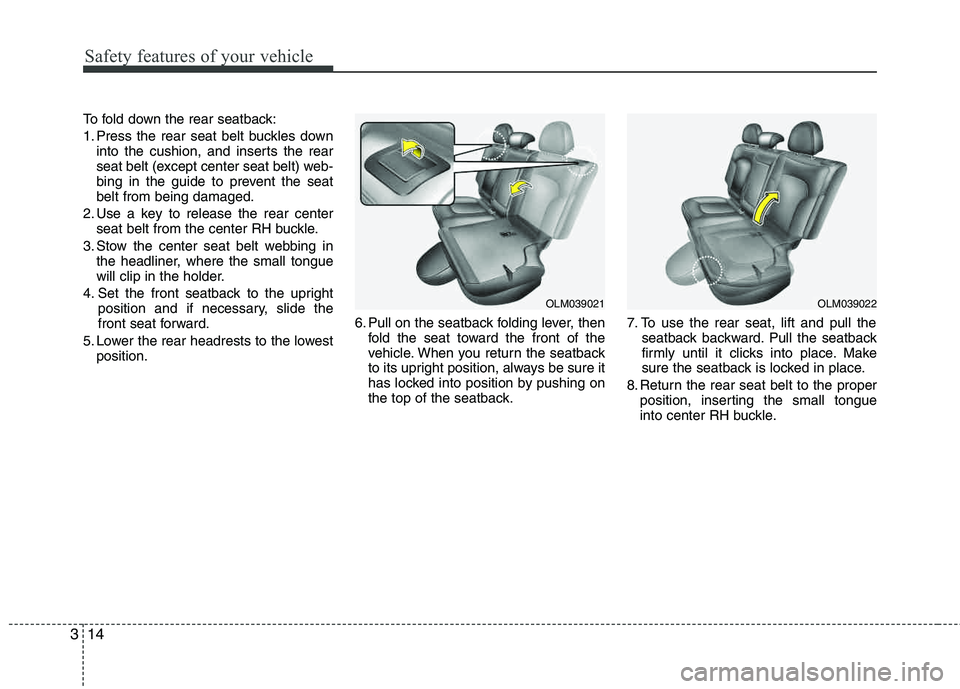
Safety features of your vehicle
14
3
To fold down the rear seatback:
1. Press the rear seat belt buckles down
into the cushion, and inserts the rear
seat belt (except center seat belt) web-
bing in the guide to prevent the seat belt from being damaged.
2. Use a key to release the rear center seat belt from the center RH buckle.
3. Stow the center seat belt webbing in the headliner, where the small tongue
will clip in the holder.
4. Set the front seatback to the upright position and if necessary, slide the
front seat forward.
5. Lower the rear headrests to the lowest position. 6. Pull on the seatback folding lever, then
fold the seat toward the front of the
vehicle. When you return the seatback
to its upright position, always be sure it
has locked into position by pushing on
the top of the seatback. 7. To use the rear seat, lift and pull the
seatback backward. Pull the seatback
firmly until it clicks into place. Make
sure the seatback is locked in place.
8. Return the rear seat belt to the proper position, inserting the small tongue
into center RH buckle.
OLM039021OLM039022
Page 53 of 382
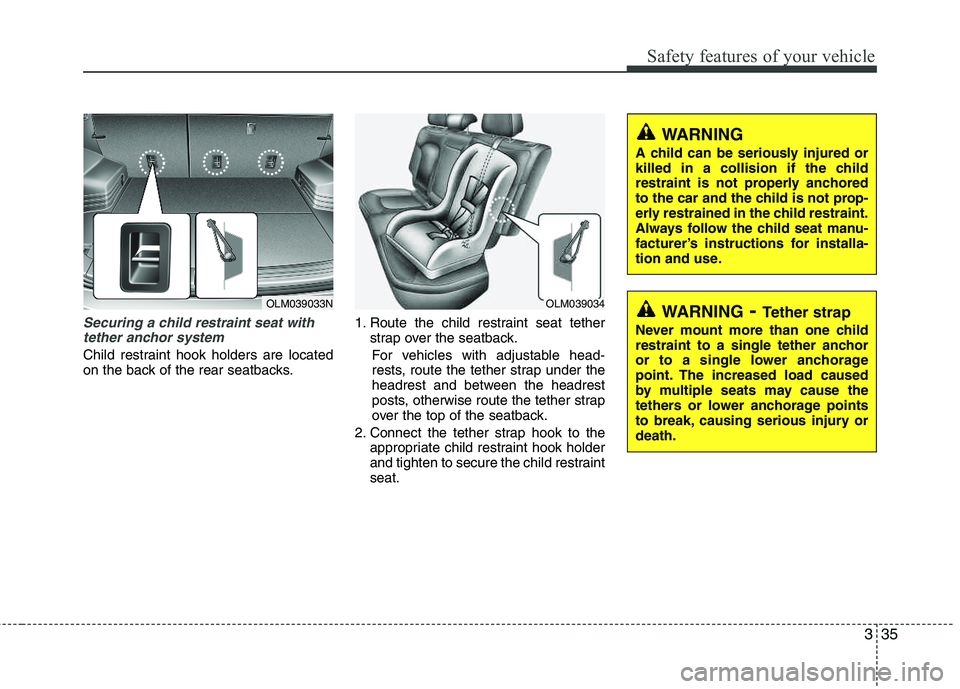
335
Safety features of your vehicle
Securing a child restraint seat withtether anchor system
Child restraint hook holders are located
on the back of the rear seatbacks. 1. Route the child restraint seat tether
strap over the seatback.
For vehicles with adjustable head-
rests, route the tether strap under the
headrest and between the headrest
posts, otherwise route the tether strap
over the top of the seatback.
2. Connect the tether strap hook to the appropriate child restraint hook holder
and tighten to secure the child restraint seat.
OLM039033NWARNING- Tether strap
Never mount more than one child
restraint to a single tether anchor
or to a single lower anchorage
point. The increased load caused
by multiple seats may cause the
tethers or lower anchorage points
to break, causing serious injury or death.
WARNING
A child can be seriously injured or
killed in a collision if the child
restraint is not properly anchored
to the car and the child is not prop-
erly restrained in the child restraint.
Always follow the child seat manu-
facturer’s instructions for installa-
tion and use.
OLM039034
Page 377 of 382
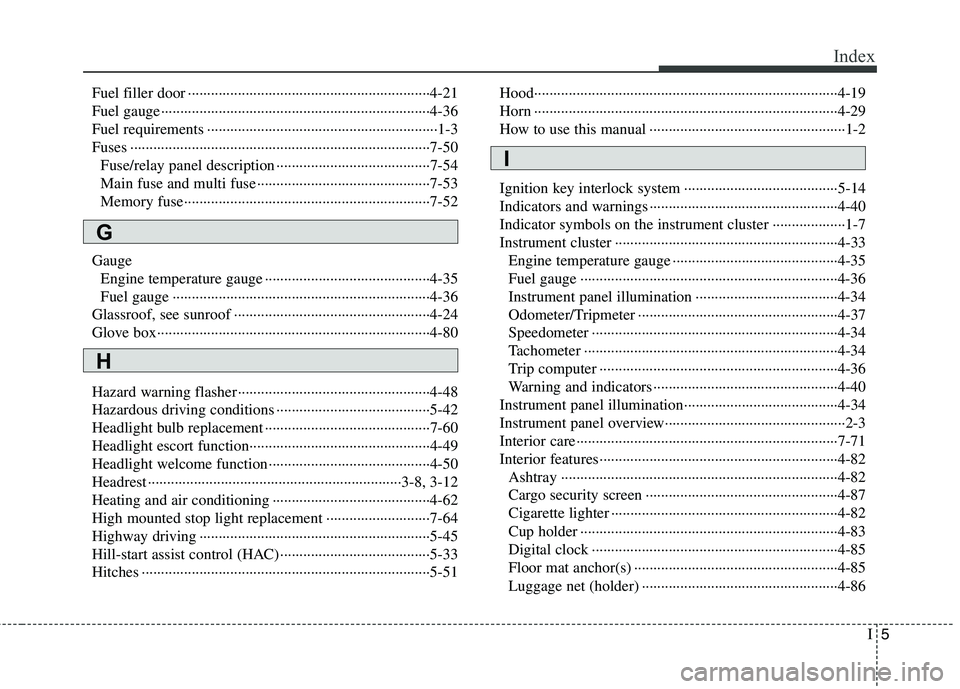
I5
Index
Fuel filler door ·······························································4-21
Fuel gauge······································································4-36
Fuel requirements ····························································1-3
Fuses ··············································································7-50Fuse/relay panel description ········································7-54
Main fuse and multi fuse ·············································7-53
Memory fuse································································7-52
Gauge Engine temperature gauge ···········································4-35
Fuel gauge ···································································4-36
Glassroof, see sunroof ···················································4-24
Glove box·······································································4-80
Hazard warning flasher ··················································4-48
Hazardous driving conditions ········································5-42
Headlight bulb replacement ···········································7-60
Headlight escort function···············································4-49
Headlight welcome function··········································4-50
Headrest ··································································3-8, 3-12
Heating and air conditioning ·········································4-62
High mounted stop light replacement ···························7-64
Highway driving ····························································5-45
Hill-start assist control (HAC) ·······································5-33
Hitches ···········································································5-51 Hood···············································································4-19
Horn ···············································································4-29
How to use this manual ···················································1-2
Ignition key interlock system ········································5-14
Indicators and warnings ·················································4-40
Indicator symbols on the instrument cluster ···················1-7
Instrument cluster ··························································4-33
Engine temperature gauge ···········································4-35
Fuel gauge ···································································4-36
Instrument panel illumination ·····································4-34
Odometer/Tripmeter ····················································4-37
Speedometer ································································4-34
Tachometer ··································································4-34
Trip computer ······························································4-36
Warning and indicators ················································4-40
Instrument panel illumination········································4-34
Instrument panel overview···············································2-3
Interior care····································································7-71
Interior features······························································4-82 Ashtray ········································································4-82
Cargo security screen ··················································4-87
Cigarette lighter ···························································4-82
Cup holder ···································································4-83
Digital clock ································································4-85
Floor mat anchor(s) ·····················································4-85
Luggage net (holder) ···················································4-86
G
I
H